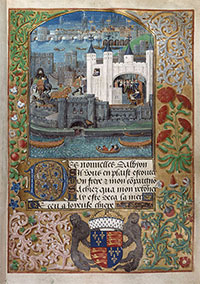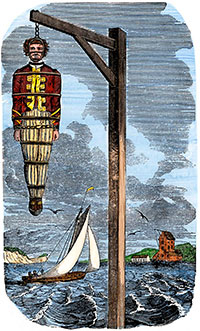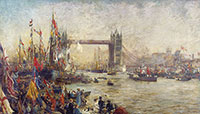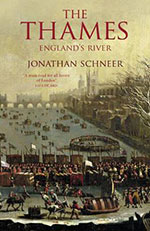
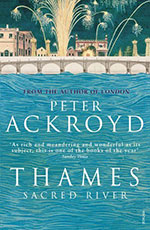
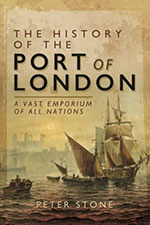
60 First London Bridge built of wood by the Romans.
9th Century
886 Alfred the Great drove the Viking invaders out and London recovered to move to an great age of trade.
893 Edward the Elder son of Alfred the Great, forced invading Vikings to take refuge on Thorney Island. Thorney Island was an eyelet on Thames.
10th Century
960 St Peters Abbey founded on Thorney Island after King Edgar installed a community of Benedictine monks. At high tide, their settlement was completely surrounded by the then much wider Thames. Origin of Westminster Abbey.
980 The Vikings occupied London.
11th Century
1014 Ethelred recaptured the City from the Vikings. He attached ropes to the supports of a heavily defended London Bridge, then headed downstream tearing part of the bridge down.
1016 Palace of Westminster built on Thorney island.
1065 Dec: St Peters Abbey rebuilt as Westminster Abbey a royal church and consecrated. Edward the Confessor established the historic division between the centre for trade – the City of London – and that of government – the City of Westminster.
1066 Jan: Edward the Confessor died and buried at Westminster Abbey.

Dec: William the Conqueror crowned at Westminster Abbey.
1078 White Tower built by the Thames by William the Conqueror to control London.
13th Century
1200 Archbishop Hubert Walter built Lambeth House (now Lambeth Palace).
1209 London Bridge rebuilt in stone. Shops and a chapel added.
1240 The very first Parliament sat at the Palace of Westminster.
14th Century
As well as a row of shops and a chapel, London Bridge now had 198 houses over its 350 yards length. It was longest bridge in Europe.
1305 William Wallace’s head was displayed at Southwark Gate on London Bridge after his execution. First of many heads to be displayed there.
1381 Lambeth Palace sacked during Peasant's Revolt.
15th Century
Admiralty established Execution Dock at Wapping where pirates were hung.
1427 Greenwich Palace built by Humphrey, Duke of Gloucester (1390-1447).
1433 Thames froze from London Bridge to Gravesend.
1452 Roger Pye is named as a lighter man, with John Maye as a water man. A lighter man moved cargo and a waterman ferried people.
16th Century
1500 Earliest known depiction of Thames from Poems of Charles, Duke of Orleans
1501 Richmond Palace built by the Thames (torn down in 1649).
1512 Palace of Westminster destroyed by fire.
Royal Dockyard opened at Woolwich.
1513 Royal Dock built at Deptford, became known as King's Yard.
1514 Act of Parliament regulated the fares watermen charged on the Thames.
1515 Carriages travelled on the icy surface from Lambeth to Westminster.
1530 Whitehall Palace built by Henry VIII to replace Westminster (destroyed in fire in 1512).
1536 King Henry VIII rode to his palace at Greenwich on the frozen Thames with Queen Jane.
1544 Royal Dock at Deptford become most important Dock in England.
1555 Act of Parliament introduced to control Watermen and Wherrymen working between Gravesend and Windsor. It gave the City of London the power to appoint eight watermen as overseers. It also stipulated that watermen had to serve apprenticeships and be licensed, and in fact brought about the formation of the Watermen’s Company, the only City guild to be formed by Act of Parliament.
1558 Elizabeth I appointed 20 wharves as moorings for sea trade.
c.1570 - 1605 Civitas Londinium, Agas' Map of London from Westminster to Tower of London (click on linked page to expand map).
1581 Francis Drake knighted by Elizabeth I at Deptford.
1588 Fear of invasion by Spain remained high in England, especially with the action of the Spanish Armada taking place so close to England's shores. Robert Dudley was put in charge of the land army at Tilbury, on the Thames, in Essex. Dudley arranged for Queen Elizabeth to visit Tilbury to announce his appointment and rally the troops on 9 August.
1598 John Stow, in his Survey of London, related that some 40,000 men earned a living on or about the river.
17th Century
1606 Fourteen years before the Pilgrim Fathers set out from Plymouth, three small ships, the Susan Constant, Godspeed and Discovery, none over 100 tons, sailed from Blackwall and founded the state of Virginia.
1607 Frost fair recorded. During December the ice had been firm enough to allow people to walk between Southwark to the City, and in January the ice became thick enough for people to set up camp on it. There were football pitches, bowling matches, fruit-sellers, shoemakers, barbers plus taverns. To keep the shopkeepers warm, there were even fires within their tents.
1620 Mayflower left Rotherhithe to Plymouth to collect the Pilgrim Fathers and sail on to the New World.
1630 Old London Bridge by Claude de Jongh (c.1603–1663)

1647 The Long View of London from Bankside. Etching by Wenceslaus Hollar (1607–1677).
1664 A bridge at Westminster proposed, but opposed by the Corporation of London and the watermen
1666 Great Fire of London (1675 painting).
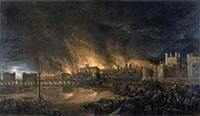
1667 Dutch fleet sailed up the Thames Estuary and captured the fort at Sheerness then burnt 13 English ships at Chatham.

1683 Thames froze to a thickness of 11 inches and a Frost Fair was established.
Painting by unknown artist with London Bridge in the distance.
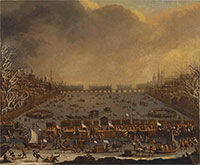
c. 1695 Print of Whitehall Palace by Leonard Knyff (1650-1722)

1698 Whitehall Palace destroyed by fire.
First definite records of properly organised rowing matches in Gravesend, Kent.
1699 Billingsgate Fish Market formerly established in the City of London..

Howland Great Wet Dock opened in Rotherhithe (later Greenland Dock).
18th Century
1700 Lightermen joined the Company of Watermen. Now Company of Watermen & Lightermen.
1701 Captain Kidd hung at Execution Dock in Wapping. His tarred body was left in chains at Tilbury Point as a warning to others.
1715 First Doggett's Coat and Badge race on the Thames by up to six apprentice watermen. The oldest rowing race in the world.
1717 Handel’s Water Music composed in response to King George 1’s request for a concert on the Thames
1727 St Anne's Limehouse by Nicholas Hawksmoor (c. 1661-1736) completed. 60m-high tower used to be a ‘Trinity House mark’ for navigation on the Thames. Hence why it flew the Royal Navy’s white ensign.
1729 Putney Bridge opened. Built of wood.
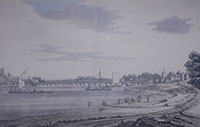
c1749 The Thames at Westminster by Canaletto (1697–1768).
Westminster Bridge can be seen under construction.
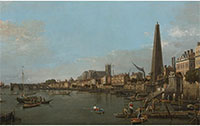
1750 Westminster Bridge opened.
1757 Old London Bridge before alteration. Painting by Samuel Scott (1702-1772)

1759 Kew Bridge opened.
1763 Houses on London Bridge removed and bridge widened.
1769 Blackfriars Bridge opened.
1773 Battersea Bridge opened.
1777 Richmond Bridge opened.
1785 Vauxhall Gardens opened by Thames.
1790 Brunswick Dock opened (later East Indies)
1794 Landscape view of Deptford Dockyard by Joseph Farington (1747-1821) .
1798 Marine Police established by West India Committee to protect trade. It is claimed that the Marine Police was England's first ever police force.

19th Century
1800 Marine Police replaced by Thames River Police. Formed to tackle theft and looting from ships anchored in the Pool of London. An estimated £500,000 of imports stolen every year from the London Docks.
1805 West Indies Dock opened on the Isle of Dogs "for rendering more commodious and better regulating the Port of London”
London Dock opened in Wapping.
1806 East India Dock opened in Blackwall.
Admiral Nelson’s funeral procession on the River Thames, to the Admiralty in Whitehall, after his lying in state at the Royal Hospital for Seamen at Greenwich.
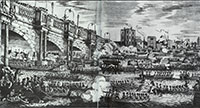
1807 Surrey Commercial Docks opened in Rotherhithe.
1811 First Teddington Lock built.
1814 Jan: The Thames froze for the last time.
1815 Steam boats introduced on the Thames.
1816 Vauxhall Bridge opened.
1817 Waterloo Bridge opened.
1820 Paintings showing a number of Thames watermen.
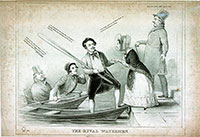
1825 Work began on Thames Tunnel connecting Rotherhithe and Wapping. Designed by Marc Isambard Brunel (1769-1849) and his son Isambard Kingdom Brunel (1806-1859).
1828 New Kingston Bridge to replace old wooden bridge
St Katherines Dock opened. Designed by Thomas Telford.
1831 New London Bridge opened.
1834 Palace of Westminster (housed Parliament) destroyed by fire.
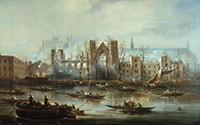
1836 Oxford & Cambridge Boat Race moved from Henley to a course from Westminster to Putney.
1839 Marine Police Force merged into the Metropolitan Police Force, retaining its Wapping base. Initially patrols continued in rowing boats, some of which remained in use until 1905.
1840 Work started on new Houses of Parliament.
1841 Earliest photo of River Thames by Fox Talbot.
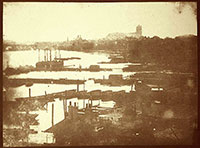
1843 Thames Tunnel completed by Isambard Kingdom Brunel.
1846 Gravesend Regatta established. Now one of the oldest regattas in the UK
1855 Royal Victoria Dock opened on a previously uninhabited area of the Plaistow Marshes. It was the first of the Royal Docks and the first London dock to be designed specifically to accommodate large steam ships.
1857 Victor Prout (1835-1877) photographed the Thames from London to Oxford.
1858 Clock Tower, housing Big Ben, completed.
Great Eastern, built at Millwall by Isambard Kingdom Brunel.
_beside_the_Great_Eastern_c1857s.jpg)
Cholera outbreak caused the Great Stink.
1860 Most of new Houses of Parliament competed. The site was extended into the river by reclaiming land, to a total of about eight acres.
1862 New Westminster Bridge completed. Seven arch cast iron-bridge with Gothic detailing by Charles Barry.
1863 Battersea Railway Bridge opened.
1865 The East London Railway Company purchased the Thames Tunnel and four years later the first trains used it.
1868 Millwall Docks opened on Isle of Dogs.
1869 Albert embankment built.
1870 Victoria embankment built.
1872 Police building at 100 Wapping High Street built with workshops for boat building and a jetty for moorings.
1875 Steam overtook sail ail in the tonnage of vessels that used the Port of London. Steam represented 5.1 million tons and sail only 3.6 million tons.
1878 Paddle steamer SS Princess Alice, collided with the Bywell Castle near Woolwich. Between 600 and 700 people died.
1880 The Royal Albert Dock opened. At the time was the largest and finest dock in the world.
1886 Tilbury Docks opened in Essex.
1889 Woolwich Ferry established.
Dockers Strike.
1894 Tower Bridge under construction.
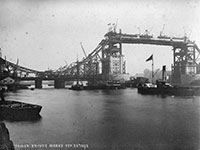
1897 Blackwall tunnel opened.
20th Century
1902 Greenwich Foot Tunnel opened.
1907, Joseph Mears (1871-1935) acquired the business of the Thames Electric & Motor Launch Co at Eel Pie Island. He built up the largest fleet of passenger launches on the Thames.
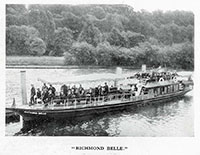
1908 Rotherhithe Tunnel opened.
1909 Port of London Authority (PLA) created with the duty of making good any deficiencies in the Port’s accommodation, equipment and service both for ships and goods; to carry out all conservancy duties over sixty-nine miles of the tidal Thames and exercise the powers hitherto vested in the Watermen’s Company relative to the registration and licensing of craft and boats as well as lightermen and watermen.
1912 Woolwich Foot Tunnel opened.
1920s Film of a journey down the Thames from London Docks to Essex. Shown: Tower Bridge, Greenwich Hospital, Tilbury, Canvey Island, Benfleet and Southend
1928 The River Thames flooded, bursting its banks at Lambeth.
Work started on Battersea Power Station.
1935 Colour film of the Thames.
1940 May: Teddington Lock was the assembly point for an enormous fleet of small ships from the length of the River Thames to aid in evacuation of the British army from Dunkirk, France.
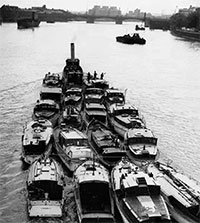
Sept: The Blitz. Surrey Docks bombed.
1942 New Waterloo Bridge completed.
1942-3 Maunsell Forts (armed towers) forts built in the Thames Estuary.
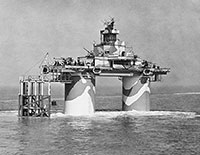
1951 Festival of Britain began.
Royal Festival Hall opened on the South Bank.
1953 Canvey Island Floods
1954 Cutty Sark transferred to permanent dry dock at Greenwich.

1955 Battersea Power Station completed.
1962 River Thames Society formed to conserve the river for future generations and represents all river users whether they be fishermen, walkers, boat owners or just interested in its very rich history, traditions, flora and fauna.
1963 Dartford Tunnel opened.
1965 Sir Winston Churchill’s funeral flotilla, led by the Havengore vessel, carried his body & his coffin up the River Thames to Temple Pier. Notice the dipped cranes. Film
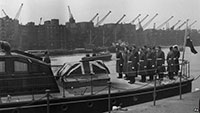
Colour film of Thames.
1967 Container port opened in Tilbury, Essex. Led to decline of London Docks.
East Indies Docks closed in Blackwell.
1968 St Katherines Dock closed & became a marina.
1969 London Docks closed in Wapping.
1970 Surrey Commercial Docks closed in Rotherhithe.
1971 HMS Belfast moored near Tower Bridge.
1973 New London Bridge opened.
1976 Thames Hydrofoils introduced by P&O Film. Only ran for a few years.
1977 7 June: Sex Pistols gig on Thames stopped by police Film
1978 Battersea Power Station decommissioned.
1980 West Indies Docks closed.
1981 Royal Docks closed.
1982 Thames Barrier opened.
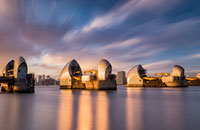
Billingsgate Fish Market moved.
1989 Aug: Marchioness Disaster.51 people died in a collision.
1991 One Canada Square built on the Isle of Dogs. It was the UK's tallest building at the time and a symbol of the regeneration of Docklands.
Queen Elizabeth II Bridge opened between Dartford and Thurrock as part of the M25.
1996 Thames Path opened. Runs from source in Gloucestershire to Thames Barrier at Charlton
1997 First Thames Festival held (every September).
1999 Millennium Dome opened at Greenwich.
Thames Clippers founded by Sean Collins and Alan Woods.
21st Century
2000 Tate Modern opened on Bankside.
London Eye opened on South Bank.
2002 RNLI station Lifeboat Station opened at Tower Pier next to the Tower of London.
2012 Thames Diamond Jubilee River Pageant river procession with 1,000 boats Film
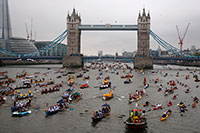
London Cable Car linked Greenwich to Royal Docks.
Tall Ships visited London.
2013 London Gateway container port opened in Thurrock, Essex.
2016 Nigel Farage and Bob Geldof's rival EU referendum flotillas clash on the Thames Film
2017 Tall Ships Royal Greenwich (photos).
Terrorist attacks on Westminster Bridge and London Bridge.
2019 Illuminated River artwork started with four bridges: London, Cannon Street, Southwark and Millennium.
2021 Five more bridges illuminated: Blackfriars, Waterloo, Golden Jubilee, Westminster and Lambeth.
2022 Battersea Power station opened to the public.
Book List:
The Book of the Thames: From Its Rise to its Fall - Mr. and Mrs S.G. Hall with photos by Prout (1865)
The HistoricThames - Hilaire Belloc (JM Dent 1907)
Thames Highway - Fred S. Thacker (1914)
Thames Highway Vol 2: Locks & Weirs - Fred Thacker (1914)
Father Thames - Walter Higgins (Frederick A. Stokes Co, 1923)
Sweet Thames Run Softly - Robert Gibbings (JM Dent 1940)
The Thames - AP Herbert (Weidenfeld & Nicolson 1966)
Nicholsons Guide To Thames (1969)
View of the Thames - Norman Shrapnel (Collins 1977)
London’s Lost Riverscape - C Elmers & A Werner (Viking 1988)
London's River - Gavin Weightman (Collins & Brown 1990)
The Thames - Jonathan Schneer (Yale 2005)
Thames: Sacred River - Peter Ackroyd (Chatto 2007)
London's Bridges - Peter Matthews (2008 Shire)
River Thames from Source to Sea: Sixty glorious photographs, Taken in 1880 - Andrew Gill (2014)
The History of the Port of London: A Vast Emporium of All Nations - Peter Stone (Pen & Sword 2021)
Thames Mudlarking: Searching for London's Lost Treasures - Jason Sandy & Nick Stevens
London Thames Path - David Fathers (2022 Frances Lincoln)
Online:
Port of London Authority
South Side Pubs from Weybridge to Whitstable
Bermondsey Riverside Property Guide
Rotherhithe Riverside Property Guide
Deptford Riverside Property Guide
